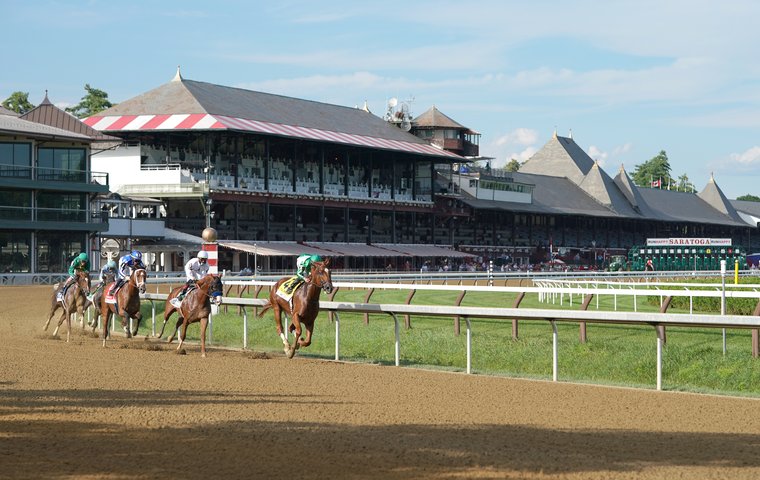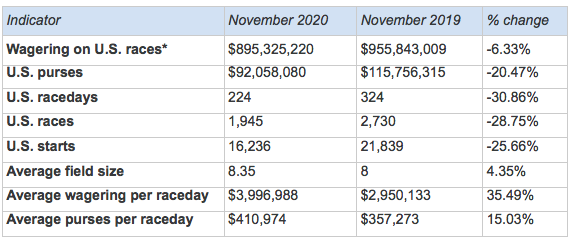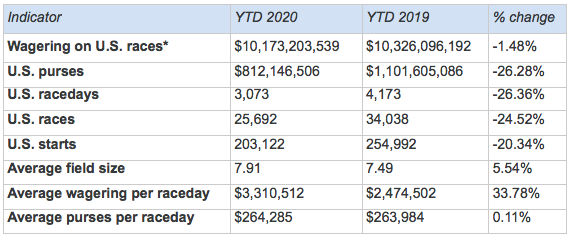
The racing year, 2020, is winding down and, despite the Covid-19 pandemic, which has changed all our lives, the economics of racing and racetracks in the U.S. have performed better than we might have expected back in March.
I understand that the breeding and sales businesses have faced substantial challenges, but that is not a part of the Thoroughbred industry that I can intelligently comment on.
These are the points I would like to comment on:
- A year-to-date review of industry wagering handle through November with a look at a few of the larger racetracks in the U.S.
- The racetracks and racing industry are getting serious about integrity, equine safety and trying to take the racing back from the cheaters.
- The Horseracing Integrity And Safety Act of 2020.
1. Wagering handle
Let’s begin by looking at the total U.S. handle for the past five years with the percentage change from the prior year.
2015 - $10.675 billion (+1.2%)
2016 - $10.744 billion (+0.6%)
2017 - $10.909 billion (+1.5%)
2018 - $11.267 billion (+3.3%)
2019 - $11,037 billion (-2.0%)
One could conclude that handle has been flat for the last five years, which would be correct. However, in 2005 handle was $14.561 billion, meaning a decline of 24.2% from 2005-2019. Most of us would not have wanted to have invested in that business in 2005, but many industry participants did.
Let’s focus on the YTD (year to date) November numbers. Keep in mind that most racetracks stopped operating for two to three months in mid-March and, in most cases, operated without customers in the seats for the last nine months of the year.
To be honest, I find that total wagering on U.S. races through November 2020 to only be off by 1.48% is remarkable, especially when one considers that the total YTD wagers were off by 1.48% when the total number of races through November declined by 28.75% and total purses by 20.47%.
The most remarkable and encouraging number to me is that the average wagering per raceday showed an increase of 33.78% YTD compared to the equivalent 2019 number. I do not have access as to the source of this increase in 2020, but two factors had to be the dramatic increase in television coverage and the ADW (advance deposit wagering) promotion of the larger racetracks. It would be very interesting to know if there were significant new customers or did the ADWs do a better job in marketing to their regular clients.
Since three of the largest ADWs are owned by racetracks, I suspect they would know the answer but may not be entirely willing to share that information. However, I would hope that any significant racetrack would have an audit clause with its ADW partners and could get better information as to where the increases came from.
Economic indicators for November 2020
YTD 2020 vs YTD 2019
* Includes worldwide commingling wafering on U.S. races
Source: Equibase
Here are some wagering statistics for 2020 for Saratoga, Woodbine, Santa Anita and Del Mar.
Saratoga
In 2019, the racecourse set a record all-source handle of $705.3 million in a 39-day meet in 2019 for an average daily handle of $18.1 million. In 2020, it almost matched that record, at $702.5 million in a 40-day meet, for an average daily handle of $17.6 million. The 2020 handle performance with no on-track customers was remarkable since the attendance for the 2019 meet had been 1,056,053 customers for the 40-day meet.
Woodbine
The Toronto operation had a reduced racing schedule at both the beginning and at the end of the meet due to Covid-19. That resulted in 35 fewer racedays and 305 fewer races. However, the 2020 all-source handle was $391.4 million, which was only down less than 3% despite running 27% fewer racecards. Handle per race in 2020 was $509,417, which was 19.6% higher than 2019.
Del Mar
The California track ran a 36-day meet in the summer of 2019, but that was cut back to 27 days in 2020. Despite this, all-source handle in 2020 ($466.68 million) was 8% higher than the $431.98 million in 2019. Average daily handle for the 2020 meet was $17.28 million, compared to the 2019 daily average of $12.0 million.
Santa Anita
The fall meet in 2019 had 19 racing days with a total all-source handle of $167.3 million for an average daily handle of $8,789,472. This year, the fall meet had 22 racing days with an all-source handle of $206.7 million and an average daily handle of $9,395,455 - 7% higher.
So the higher-quality meets certainly held their own on handle.
While the handle numbers for these premier meetings held up very well year on year, most racetracks would receive more money for themselves and their purse account from an on-track bet than they will receive from an ADW customer. With very few tracks operating to take customers on track, the overwhelming majority of bets on horseracing is currently coming from ADWs.
There undoubtedly will be pressure from owners and horsemen’s groups to better understand the economics of the ADW bet as compared to the live on-track wager.
2. Getting serious about safety
The 2019 Santa Anita winter meet was one of the lowest points in Thoroughbred racing of the last decade. From December 30, 2018, to March 31, 2019, 23 horses died, and 37 in total died across the 2019 season.
Anyone remotely familiar with racing knows the background as the situation was covered by all major media. Here are two relevant documents:
This open letter from Belinda Stronach, President of The Stronach Group, owner of Santa Anita, which laid out an ambitious and ultimately successful action plan in response to the horse deaths.
And this one, issued a year later, which is the investigation from the California Horse Racing Board (CHRB).
However, the real story is how the racing industry responded to the large number of deaths, which many thought could mark the end of Thoroughbred racing in California.
Everyone in racing realized that what happened at Santa Anita was a serious problem. Fortunately, it was a wake-up call that people throughout the industry responded to with action.
In 2020, the changes in practices and policies worked. The main dirt track at Santa Anita has not had a racing fatality in 2020, including the 2019-2020 Winter/Spring meet that began in December. In 2020 there have been five racing fatalities (presumably on the turf) from 5,069 starts or .98 fatalities per 1,000 starters, which is below the national average of 1.68.
Another California quality track, Del Mar runs a two-month summer meet and a one-month fall meet. Del Mar had an excellent record on equine safety with just one racing fatality and two training deaths for all 2020, again below the national average.
This has been a sincere effort working to change policies and practices. Frank Angst, writer for The Blood-Horse (October 26, 2020) quoted Dr Rick Arthur, the CHRB Equine Medical Director, as saying, “We’ve seen a real change in the culture when it comes to safety. That’s what has allowed us to accomplish these improvements. Really, if it gets to the point that the regulatory vets have to scratch a horse, that’s not where we want to be. The horsemen are self-regulating, which is what we need. They’re the ones that know the horse more than we ever will.”
A number of serious and important new initiatives have started in many areas of the industry regarding equine safety and medication. For example, a coalition of leading Thoroughbred racing associations and organizations announced in April 2019 a new initiative committed to phasing out the use of Furosemide (Lasix) beginning in 2020 and eliminating its use in stakes run at their racetracks beginning in 2021.
Coalition racetracks that have signed on to this initiative include all those owned or operated by Churchill Downs Incorporated (CDI), the New York Racing Association (NYRA) and The Stronach Group, as well as Del Mar, Keeneland, Lone Star Park and Remington Park, Los Alamitos Racecourse (Thoroughbred), Oaklawn Park and Tampa Bay Downs.
Taken together, these tracks represent 86 percent of the stakes races assigned Graded or listed status in the United States in 2019.
The coalition tracks will work diligently with their respective horsemen's associations and racing commissions towards implementing this effort. This was an important initiative in response to the excessive use of Lasix in the overwhelming majority of horses entered in a race.
In response to all 2-year-old horses running without Lasix in 2020, major U.S. racing organizations have agreed to jointly fund a first-of-its-kind study on the effects of Furosemide in 2-year-olds. It is remarkable that over 90 percent of the horses previously entered in a Thoroughbred race would run on Lasix and, to this point, there had never been a proper U.S. study of the effects of Lasix on horses.
The racing organizations funding this initiative include The Stronach Group, the Breeders’ Cup, CDI, Keeneland, the Kentucky Horse Racing Commission, the Kentucky Thoroughbred Association and the New York Racing Association.
Keeping horses sound
Meanwhile, the University of California-Davis Center for Equine Health has been funded by the Grayson-Jockey Club Research Foundation among others to develop technology solutions for keeping racehorses sound. The Stronach Group also donated $500,000 to UC-Davis to help the development and its installation at Santa Anita. Click here to read about this new technology, which can identify pre-existing conditions in a racehorse and help prevent catastrophic breakdowns.
In the article, the author, Mathieu Spriet, Associate Professor at UC-Davis, writes, “Previous necropsy research on horses which suffered breakdowns has shown that changes can be present in the bones prior to the development of major injuries. The goal of the Californian PET project is to detect these warning signs in order to avoid training and racing horses at high risk for catastrophic breakdown.”
Mid-Atlantic initiative
In the absence of proper oversight by individual state racing commissions, racetracks and regional horsemen’s groups are organizing to increase integrity and promote best practices in Thoroughbred racing.
A great example of this is the Mid-Atlantic Strategic Plan to Reduce Equine Fatalities. This represents racetracks and horsemen’s organizations from the states of Delaware, Maryland, New York, New Jersey, Pennsylvania, West Virginia and Virginia. Click here for more - I guarantee you will be impressed by the breadth and details of their initiatives.
3. The Horseracing Integrity and Safety Act
Finally, I save the best until last. The single most important Thoroughbred racing legislative initiative since the Interstate Horseracing Act of 1978 is the Horseracing Integrity and Safety Act of 2020. The bill, which passed the House of Representatives by a unanimous voice vote on September 29, recognizes the Horseracing Integrity and Safety Authority for purposes of developing and implementing a horseracing anti-doping and medication control program and a racetrack safety program.
The bill designates the United States Anti-Doping Agency (USADA) as the entity to manage all aspects of Thoroughbred racing anti-doping medication control and enforcement.
After a revised bill passed the House, Senate Majority Leader Mitch McConnell (R-KY) and Kirsten Gillibrand (D-NY) introduced this bill, which is said to have wide support on both sides of the aisle. McConnell also announced the launch of the Horseracing Integrity and Safety Authority, an independent, non-governmental regulatory body responsible for improving current regulations and bringing a new level of transparency.
The board will set national standards for track safety, anti-doping and medication rules, and lab protocols.
McConnell and Gillibrand’s bipartisan bill will provide federal recognition and enforcement power for the board to enable it to develop uniform, baseline standards for Thoroughbred racing. Time is running short as insiders believe that the bill needs to get passed by the Senate by the end of the third week in December. Stay tuned.
The Horseracing Integrity and Safety Act of 2020 will be a true game changer. The industry will not survive without stronger laws and penalties and desperately needs more sophistication, knowledge and enforcement in protecting the integrity and safety of the sport.


